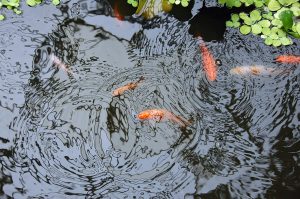
Reduce, reduce, reduce. Make every word count. I repeat these instructions every day in my EAP classroom. Session after session, I hand out exercises to reduce wordiness and replace empty, abstract words with those that are strong and specific.
And yet, the students have a hard time going “beyond the exercise” to apply these skills to their writing. They continue to fill their pages with “in the event that,” “as a result of,” and “in our society today” as well as abstracts such as “the meal was good,” “the lake was beautiful,” and “the people looked happy.”
I needed to find an authentic writing form that would encourage rich, yet spare, prose. And then it struck me—the haiku. The Japanese poem is inherently concise and relies on specific, sensory words. A win-win!
So, I initiated a “holiday haiku” activity. First, I explained the basic form: one line with five syllables, the next with seven, and the third with five. Secondly, I divided the class into small groups to brainstorm specific, image-worthy words that evoked their celebrations back home. This second stage worked beautifully. Not only did the words flow, but also the students enjoyed sharing their cultural traditions.
I then modeled two haikus, one more specific than the other, and asked the class to tell me which one was stronger and why.
| The lights are pretty on the beautiful snowflakes while the children play | Lights glisten in red and green as children scramble through crystals of white |
Although hesitant at first, the class soon peppered the online chat with ideas for haikus. Together, we counted out syllables and made revisions. Afterwards, the students went home, polished off their creations, and posted them to our class Wakelet. I was wowed by their efforts. Rich, spare, and evocative. Here are some samples:
Gingerbread houses Trees decorated in lights Smell of mandarins ~Liliya Romanenko Christmas Eve square dance Is magical to behold Dim the lights tonight ~Mileine Mouacdie Piled snow by stiff hands Fried pork with strong garlic scent Warm and cozy night ~Gloria Liu Spices and mulled wine Fortunes told on Christmas Eve (Slavic tradition). The smell of candles ~Elizabeth Romanova
Afterwards, I took some time to reflect on the activity. I was disappointed that only half the class had posted their haikus. Some students were too unsure of their work to share. Next time, I will invite everyone to send their poems to me first if they want more guidance. I suspect that others didn’t submit because there were no grades attached. I will change that as well… It’s amazing how even a mark or two can jolt students into action. Aside from the less-than-ideal submission rate, we achieved the goal that we had set for this activity: to use fewer words to say more.
The class also developed other skills in the process:
- They learned the value of using specifics over abstracts.
- They developed an appreciation for poetry and for one another’s cultures.
- They increased their vocabulary, divided words into syllables, and practiced syllable stress.
- They analyzed, parsed, compared, contrasted, discussed, and created.
Plenty of research confirms the value of poetry for ESL learners, including Aladini and Farahbod (2020), who had students write a ten-line poem, one word per line. They observed that “these rich, deeply meaningful and genuine lines motivated students to be engaged thoroughly in the process of learning” (p. 87). Robertson (2009) states that poems help students with their language structure and vocabulary. She also mentions the wide range of poetic heritages that can be shared. Other research recommends poetry for paraphrasing and summary writing (Nilon, 2020). Biancolli (2018) focuses on an ESL teacher at an immigration centre who uses haikus and tankas to help newcomers express their feelings.
I have seen the distress that Covid-19 has brought to my students, many of whom are separated from their families. Perhaps that explains why they latched onto the “holiday haiku” assignment, where they conveyed happy, comforting moments from home. Who knows?
Although short and sweet, haikus have plenty to offer. My students were excited by their work and undeniably proud of themselves. For a teacher, there’s nothing more gratifying than that. Consider a haiku for your next lesson. A little poetry can go a long way.
Please share below your thoughts and experiences with poetry in the classroom.
References
Aladini, F., & Farahbod, F. (2020). Using a unique and long forgotten authentic material in the EFL/ESL classroom: Poetry. Theory and Practice in Language Studies, 1, 83, https://doi-org.gbcprx01.georgebrown.ca/10.17507/tpls.1001.12
Biancolli, A. (2018, June 20). Immigrants’ poems reflect “feeling of finding home.” Times Union (Albany, NY).
Nilon, R. (2020). Poetic license: Using documentary poetry to teach international law students paraphrase skills. InSight: A Journal of Scholarly Teaching, 15, 142–156.

Thank you Jennifer! I am inspired to try this writing activity in class. Your article was well written and to the point. I used an acrostic poem to introduce myself to the class one session. The first word of each line of the poem spelled my name and each line gave some information about me. This could be another version of this activity!
Thank you, Monica!
Yes, I love doing this activity with them. It really livens them up.
And great idea about the “get to know you” poem. Love it 🙂
Oh my gosh, this is brilliant! I love anything that gets the creative juices flowing in the classroom but is simple enough to keep everyone engaged. This one is a winner! And thanks so much for sharing some additional resource points to reference, much appreciated.
Thanks, Sarah. I appreciate your feedback!
I hope you have fun with this activity.
Cheers,
Jennifer